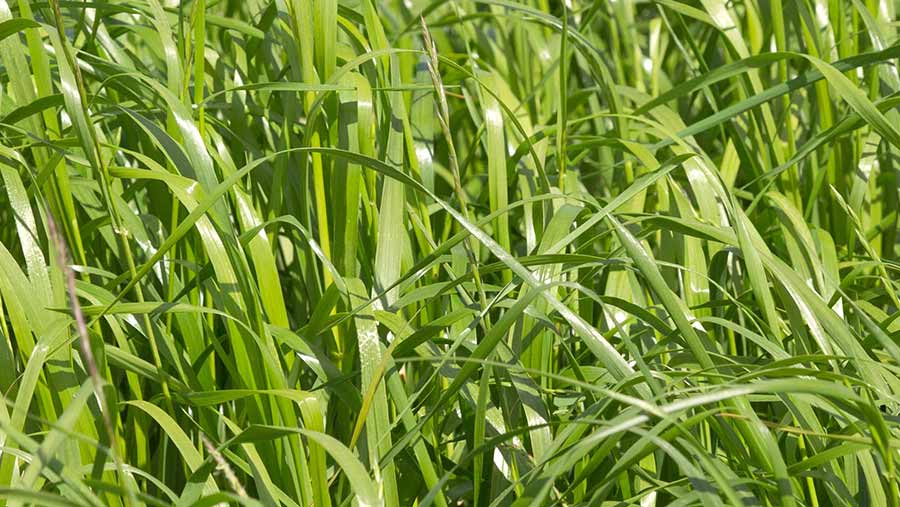The four fundamentals for growing 20t DM/ha
 © Tim Scrivener
© Tim Scrivener Dairy farmer Pat Walshe targets 500kg MS/cow with concentrate input around 500kg a head a year from his Friesian/Jersey crossbred herd near Durrow in County Laois, Ireland.
Pivotal to this is maximising grass, which Pat refers to as “the cheapest and best feed we can give livestock in a climate like ours”.
The Walshe family farm, which Pat runs with his parents Padraig and Ella, is split into two milking blocks of 50ha. In 2017, the home farm grew 21.6t DM/ha and this platform has produced an average of 17.11t DM/ha over the past five years.
See also: How to assess cow efficiency with liveweight measurement
Pat believes there are four key components to growing and utilising large amounts of grass:
He shared his farm’s practices with attendees at the 2019 Positive Farmers Conference in Cork on Wednesday 16 January.
1. Soil fertility
On his free-draining farm, soil sampling takes place every year. Mr Walshe says he believes soil fertility is the single most important issue. “If the pH is not correct, you are wasting money putting out other fertilisers.”
The average pH across the farm is 6.95, P is at an index of 4, and K was previously, but has slipped so this is a focus area for 2019.
Measures to manage soil fertility include:
- pH monitoring and P and K indexing
- Always liming when reseeding
- Spreading slurry and distributing to the areas that need it most
- Putting slurry on silage ground where possible and dirty water on paddocks that have had bales taken off them
2. Grass type/reseeding
In the past seven years, 80% of the milking platform and 60% of the outblock (young stock ground) has been reseeded.
While some swards are performing well after 30 years, the approach taken is that swards being continually cut are unlikely to last 10 years and need regular reseeding.
Management includes:
- Developing cumulative yield charts for individual paddocks each year to keep an eye on variation
- If a paddock is lagging behind on growth, it is likely to be a candidate for reseeding
- Reseeding in the spring is favoured as this is the quickest turnaround time with the least risk
- The farm is currently part of Moorepark’s grass monoculture trial and has set all monocultures on the milking platform over the past five years.
3. Infrastructure
With the milking platform split into two blocks, two miles apart on the main road, and the parlour being sited at the far end of one block, investing in a roadway through the milking platforms has been necessary to reduce the travel distance for cows.
Before this roadway was built three years ago, there were a couple of smaller roadways on the milking blocks, but cows were moved down the main road for milking.
“Good fencing with a good water supply is essential for utilisation of grass,” Mr Walshe says, and as cow numbers have increased he has enlarged paddocks, which are typically 1.5-2ha, and updated the water system with larger troughs.
“The infrastructure plays a big part in grass utilisation, especially in spring by helping us get out at almost every milking from when cows start to calve.”
4. Grass measurement and management
Padraig Walshe has been measuring grass on the farm with a plate metre since 1993, and measurement continues to be a priority for his son. There are more than 35 measurement walks a year, with grass measured weekly during the grazing season and twice weekly at peak growth.
Everyone on the farm can complete a grass cover and Pat prefers to clip and weigh the grass as he finds it more accurate and reliable.
The grass wedge is used to inform grazing decisions. Aims include:
- Closing at a cover of 850 DM/ha on 1 December and open at 1100-1150 DM/ha in spring
- Turnout in the first week of February with the second rotation finished by 31 March if possible
- Getting silage off early
- Not taking the cover down below 500 DM/ha
- Not letting the growth rate get behind demand
- Hitting a post-grazing height of 3.9-4.1cm, putting cows back into the paddock if necessary
- Ensuring a good number of rotations – in 2017 cows completed 12 rotations, but in 2018 this was back to nine as 6t DM/ha was lost in the summer months because of the drought
“We are now very happy with measuring grass, but the future will be about having the farm grass supply in the right place at the right times,” Mr Walshe says.
“That will mean better management and more budgeting. This we think can give us two weeks more grazing in the autumn and can eliminate, in very good springs, all silage supplementation.”
